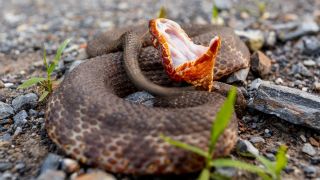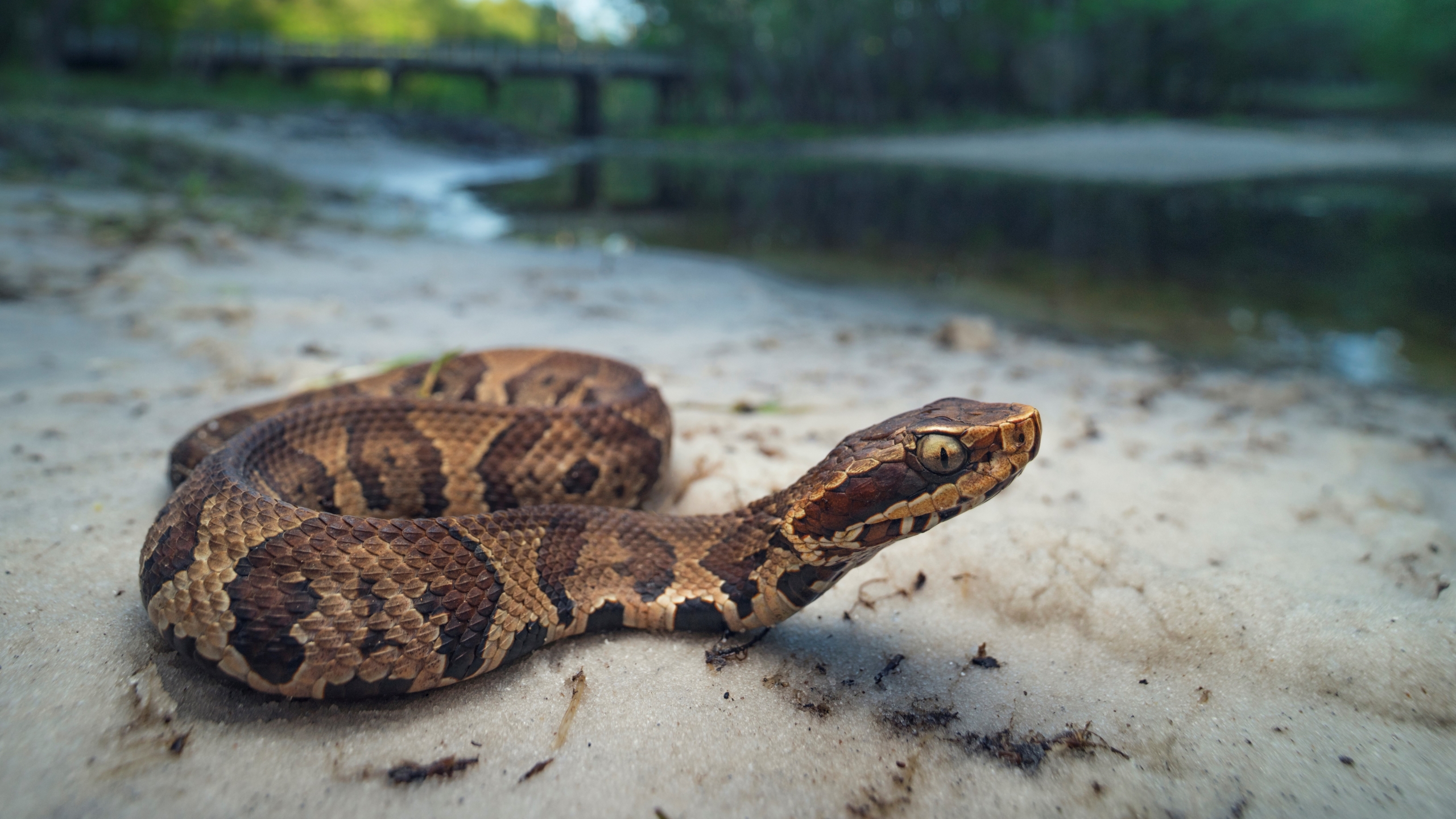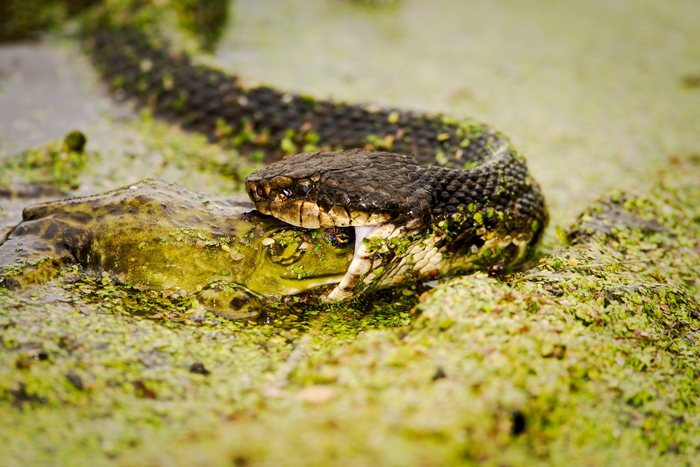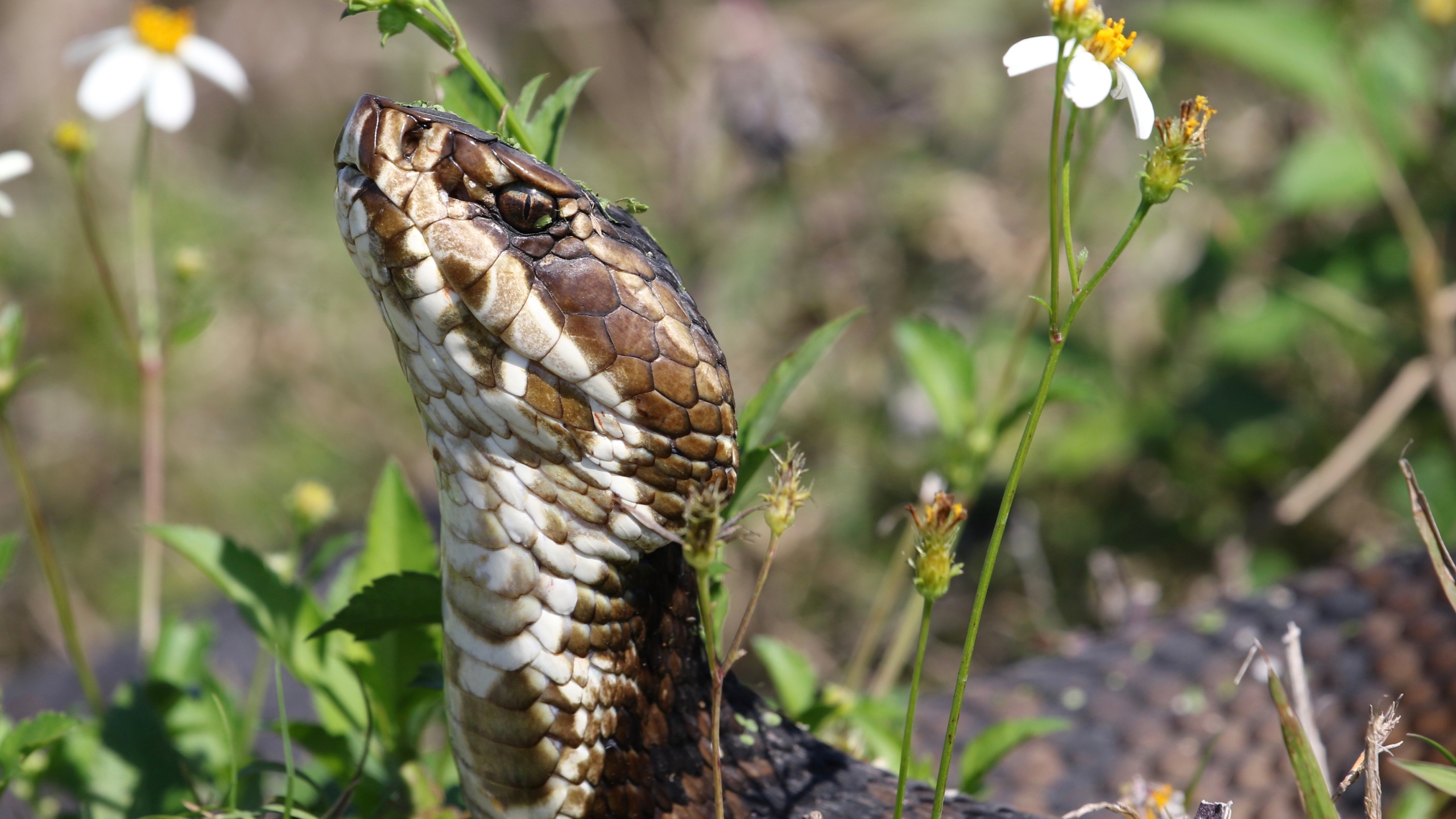Does a Baby Cotton Mouth Have a Yellow Tail
Cottonmouth snakes: Facts about h2o moccasins

Cottonmouths (Agkistrodon piscivorus), as well called water moccasins, are venomous snakes found in the southeastern United States. They're called cottonmouths because of the white coloration on the within of their mouths, which they display when threatened.
Cottonmouths are semiaquatic, then they're comfortable both swimming in water (hence their other mutual name of h2o moccasin) and basking on land. They are the only venomous serpent in the U.S. that spends a lot of fourth dimension in the water, Alive Science previously reported. Other local names for cottonmouths include blackness moccasins, gapers, mangrove rattlers, snap jaws, stub-tail snakes, swamp lions, trap jaws, water mambas and h2o pilots.
Cottonmouths are pit vipers, as are copperheads and rattlesnakes, according to Sara Viernum, a herpetologist based in Portland, Oregon. "Like all pit vipers, [cottonmouths] have heat-sensing facial pits between their eyes and nostrils," Viernum said. These specialized pits are able to detect minute differences in temperature so that the ophidian can accurately strike the source of heat, which is often potential casualty. Cottonmouths rarely bite humans, and usually only practice so when provoked.
How to identify a h2o moccasin
Cottonmouths are relatively large, ranging from two to 4 feet long (61 to 122 centimeters), according to the Savannah River Ecology Laboratory. They have thick, muscular bodies covered in keeled, or ridged, scales and blocky heads with large jowls. Their pupils are vertical, similar to cat pupils, and they take dark stripes next to each nostril. Their coloration varies from dark chocolate-brown or black to olive, banded brown or yellow.
Cottonmouths are often dislocated with nonvenomous water snake species from the genus Nerodia. Cottonmouths and Nerodia species have like coloring and patterns and are all unremarkably found near water. Even though water snakes are nonvenomous, they tin all the same bite and are often killed by humans out of fearfulness that they are cottonmouths.
At that place are a few ways you can tell a nonvenomous water snake from a venomous h2o moccasin, or cottonmouth, according to the University of Florida. Water snakes are slender compared with cottonmouths, which are thicker and heavier. Water snakes besides have longer, thinner tails, and their heads are a similar width to their necks, whereas a cottonmouth's caput is thick, blocky and noticeably wider than the snake's cervix. Water snake pupils are round, not vertical and cat-similar similar the pupils of cottonmouths. Water snakes also lack the facial pits that are characteristic of pit vipers, such as cottonmouths.
Cottonmouth taxonomy
Kingdom: Animalia
Phylum: Chordata
Class: Reptilia
Order: Squamata
Family: Viperidae
Genus & species: Agkistrodon piscivorus
Source: ITIS
When threatened, nonvenomous water snakes, such as northern water snakes (Nerodia sipedon) and southern water snakes (Nerodia fasciata), often try to announced bigger than they are past flattening their bodies and heads. This flattening makes them look more like cottonmouths. A water serpent's flattened head volition await more than triangular in shape, but not blocky and thick, like a cottonmouth's head. A water snake's caput will also still be a like width to the cervix, even when flattened. The University of Florida stated that trying to impale a snake greatly increases the risk of beingness bitten by one.
Juvenile cottonmouths have more distinctive bands across their bodies and are lighter brown compared with adult cottonmouths. Juveniles also have bright-yellow tail tips that they use equally lure to attract prey. "They undulate the tail tip slowly back and forth to lure prey, such equally frogs, within striking distance," Viernum said. The striking patterns present on the juveniles fades with historic period.

Where practice cottonmouths live?
Cottonmouths are native to the U.S. and range from southeastern Virginia to Florida, west to central Texas and north to southern Illinois and Indiana, according to the IUCN. They primarily live in aquatic and wetland habitats, including swamps, marshes, drainage ditches, ponds, lakes and streams.
The Savannah River Ecology Laboratory noted that cottonmouths can be seen yr-round during the day and at night, but they primarily hunt after dark, especially in the summer. They tin can exist found basking in the sun during the day on rocks, logs and stumps, according to the Virginia Department of Wild fauna Resource.
There are 3 subspecies of cottonmouth recognized by the Integrated Taxonomic Information Organisation (ITIS). These are Florida cottonmouths (Agkistrodon piscivorus conanti), establish throughout Florida; western cottonmouths (Agkistrodon piscivorus leucostoma), found in the species' western range, including Indiana, Illinois, Alabama, Oklahoma and Texas; and eastern cottonmouths (Agkistrodon piscivorus piscivorus), found in its eastern range, including Georgia, South Carolina, North Carolina and southeastern Virginia.
Identifying the dissimilar subspecies is hard. Their markings vary considerably, and the subspecies can interbreed where their ranges overlap. Florida cottonmouths typically have the well-nigh prominent bands and facial markings of the three subspecies, according to the U.S. Geological Survey.
What practise water moccasins eat?

Cottonmouths tin hunt prey in water or on country. They eat fish, pocket-size mammals, birds, amphibians and reptiles — including other snakes and even smaller water moccasins, according to the University of Michigan'southward Animal Diversity Web (ADW). Cottonmouths impale with a single, venomous bite, so wrap around their prey until it stops moving before swallowing their nutrient whole.
Cottonmouths mate in bound, unremarkably from April to May. During the mating process, males slither effectually, waving their tails in an attempt to lure females abroad from other male suitors. The males also fight each other when competing for females. Impregnated females have a gestation menstruum of five months, on boilerplate. Cottonmouths are ovoviviparous, which ways that eggs incubate inside the mother'south trunk. Females give birth to live young every two to three years, in litters of about 10 to twenty offspring.
Baby cottonmouths are born brightly colored and become off on their own equally soon as they're born. Most babe cottonmouths don't brand it to adulthood considering they are eaten past other animals, such equally raccoons, cats, eagles and snapping turtles.
Experts don't really know how long cottonmouths tin live. Co-ordinate to Texas Parks and Wild fauna Section (TPWD), cottonmouths live less than 10 years in the wild. However, the snakes can live much longer in captivity, and at to the lowest degree one captive cottonmouth has lived to be over 24 years erstwhile, according to ADW.
Cottonmouths may hide over wintertime in the colder, northern parts of their range. They spend hibernation in burrows fabricated by other animals, including crayfish and tortoises, or under some other form of cover, such as rotting stumps, according to the IUCN.
Cottonmouth beliefs
Cottonmouths take a reputation for being dangerous, but in reality, they rarely bite humans unless they are picked up or stepped on. They may stand their ground against potential predators, including humans, by using defensive behaviors.
"When a cottonmouth feels threatened, it will curlicue its torso and open up its mouth wide to expose the white coloration of the within of its mouth," Viernum said. The flash of white contrasts with the snake's dark trunk colors to create a startling display. "Exposing the white of the mouth serves as a alarm signal to potential predators."
Cottonmouths may too make themselves stink to deter predators by spraying a foul-smelling musk from glands in the base of operations of their tail, according to the Florida Museum of Natural History. Cottonmouths can also shake their tails a bit like a rattlesnake and can brand a vibrating sound by doing then, but they don't take an actual rattle, like rattlesnakes do.

Cottonmouth bite
Although bites are rare, cottonmouth venom is potent and can exist deadly to humans. Anyone who suffers a cottonmouth bite should seek medical attending immediately. The Centers for Illness Command and Prevention (CDC) stated that for venomous bites, the sooner antivenom can be administered, the sooner irreversible damage from the venom tin can be stopped. After calling for emergency services, the CDC recommends that snakebite victims take a photo of the serpent from a prophylactic altitude if possible, remain calm and utilise outset aid while waiting for emergency medical service personnel to arrive.
Humans bitten by pit vipers, such as cottonmouths, will almost always feel an firsthand burning pain where they've been bitten, and these bite wounds usually brainstorm to great inside five minutes, co-ordinate to TPWD. Peel discoloration around the wound is as well common.
Cottonmouth venom is mainly equanimous of hemotoxins that interruption downwardly blood cells, preventing the blood from clotting or coagulating, according to Viernum. The hemotoxins lead to "hemorrhaging throughout the circulatory arrangement wherever the venom has spread," she said. Being bitten and injected with cottonmouth venom tin lead to "temporary and/or permanent tissue and muscle harm; loss of an extremity, depending on the location of the bite; internal bleeding; and farthermost pain around the injection area," Viernum added.
The University of Florida stated that 7,000 to eight,000 people are bitten by venomous snakes in the U.Due south. each year, merely merely about five to six people die from their bites. Cottonmouths have accounted for less than one% of all snakebite deaths in the U.Southward., according to TPWD.
Conservation status
Local cottonmouth populations can exist threatened past wetland drainage for agriculture, development, and being disturbed or killed past humans. All the same, cottonmouths are categorized as a species of least concern on the IUCN Cherry-red List of Threatened Species, which ways that across nearly all of its range, the species is at low risk of extinction. Cottonmouths take a wide distribution, and the IUCN presumes that the cottonmouth population is large and relatively stable. However, the IUCN last assessed the species in 2007, and the organization states that their assessment needs updating.
Many cottonmouths live in protected state and national parks, and the species is besides protected by land law in some places. In Missouri, for example, all snakes are protected from being killed, including cottonmouths, according to the Missouri Department of Conservation.
Additional resources
- Online book: "Water Moccasin Ophidian Toxicity" (StatPearls Publishing, 2020)
- Illustrated book: "U.S. Guide to Venomous Snakes and Their Mimics" (Skyhorse, 2019). Bachelor to purchase at Amazon.
- The Virginia Herpetological Society website offers more information about cottonmouths.
This commodity was updated on June fourteen, 2021, by Alive Scientific discipline Staff Writer Patrick Pester.
Source: https://www.livescience.com/43597-facts-about-water-moccasin-cottonmouth-snakes.html
0 Response to "Does a Baby Cotton Mouth Have a Yellow Tail"
Postar um comentário